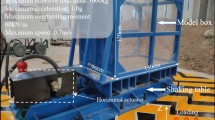Abstract
In 2016, earthquakes occurred beneath Kumamoto City, Kumamoto Prefecture in the Kyushu Region of Japan and generated numerous landslides around the city, and among those triggered in this disastrous event, the Aso-Bridge landslide was the largest. For the purpose of examining the behavior of this large-scale landslide during the main shock of the Kumamoto earthquakes, we conducted a study involving simplified sliding block concepts and finite element codes, and conclude that (a) the slope of the Aso-Bridge landslide (about 710 m high and with a dip angle of 33 °) is marginally stable in the absence of earthquakes; (b) the failure surface obtained using finite element codes is in satisfactory agreement with that of the actual failure surface; ©) our results reveal that the initiation-time of the Aso-Bridge landslide lay between 18.45 and 21 s based on three indications: (I) the directional tendency of the first apparent displacement, (ii) evidential factor of safety (FS) values <1, and (iii) Newmark’s displacement; and (d) the combination of an internal friction angle of 35 ° and a cohesion value of 80 kPa led to a failure surface closest to that observed in the field. The study demonstrates that we were able to apply the simplified sliding concepts and finite element codes to analyze the Aso-Bridge landslide in reasonable agreement with the actual event.












Similar content being viewed by others
References
Biot MA (1941) General theory of three-dimensional consolidation. J Appl Phys 12:155–164
Chen TC, Lin ML, Wang KL (2014) Landslide seismic signal recognition and mobility for an earthquake-induced rockslide in Tsaoling, Taiwan. Eng Geol 171:31–44
Chigira M (2007) Location of the landslides - prediction of potential large-scale landslide sites. Kinmiraisha, Nagoya, p 256 in Japanese
Cowin SC (1974) Constitutive relations that imply a generalized Mohr-Coulomb criterion. Acta Mechanics 20:41–46
Dadson SJ, Hovius N, Chen H, Dade WB, Lin JC, Hsu ML, Lin CW, Horng MJ, Chen TC, Milliman J, Colin PS (2004) Earthquake-triggered increase in sediment delivery from an active mountain belt. Geology 32:733–736
Duncan JM, Wright SG (2005) Soil strength and slope stability. Wiley, Hoboken
Eberhardt E, Stead D, Coggan JS (2004) Numerical analysis of initiation and progressive failure in natural rock slopes – the 1991 Randa rockslide. Int J Rock Mech Min Sci 41:69–87
Ho DJ, Chang WS, Lin CW, Liu SH (2014) Topographic characteristics interpretation of potential deep-seated landslides from Digital Elevation and remote sensing images. J Photogramm Remote Sens 18:109–127 in Chinese
Huang CC, Lee YH, Liu HP, Keefer DK, Jibson RW (2001) Influence of surface-normal ground acceleration on the Initation of the Jih-Feng-Erh-Shan landslide during the 1999 chi-chi earthquake, Taiwan. Bull Seismol Soc Am 91(5):953–958
Jibson RW (1993) Predicting earthquake-induced landslide displacements using Newmark’s sliding block analysis. Transp Res Rec 1411:9–17
Jibson RW (2007) Regression models for estimating coseismic landslide displacement. Eng Geol 91:209–218
Jibson RW, Keefer DK (1989) Statistical analysis of factors affecting landslide distribution in the New Madrid seismic zone, Tennessee and Kentucky. Eng Geol 27:509–542
JMA (2016) About the earthquake in the Kumamoto area of Kumamoto Prefecture, around 21:26 April 14, 2016. Japan Meteorological Agency. in Japanese
Keefer DK (1984) Landslides caused by earthquakes. Geol Soc Am Bull 95:406–421
Keefer DK (2000) Statistical analysis of an earthquake-induced landslide distribution – the 1989 Loma Prieta, California event. Eng Geol 58:231–249
Ling HI, Cheng ADH (1997) Rock sliding induced by seismic force. Int J Rock Mech Min Sci 34:1021–1029
Ling HI, Leshchinsky D (1995) Seismic performance of simple slopes. Soils Found 35:85–94
Ling H, Ling HI, Kawabata T (2014) Revisiting Nigawa landslide of the 1995 Kobe earthquake. Geotechnique 64:400–404
Meunier P, Hovius N, Haines JA (2008) Topographic site effects and the location of earthquake induced landslides. Earth Planet Sci Lett 275:221–232
Mikami M, Kunimura S, Okui Y, Wu X, Takebayashi T (2004) Evaluation of the strength property of rocks focused on the deformations in tunneling. Paper presented at the 33th Rock Mechanics Symposium, Tokyo. Japan Society of Civil Engineering, Tokyo, pp 109-114 in Japanese
Miyabuchi Y (2016) Landslide disaster triggered by the 2016 Kumamoto earthquake in and around Minamiaso Village, western part of Aso caldera, southwestern Japan. J Geogr (Chigaku Zasshi) 125(3):421–429 in Japanese
Newmark NM (1965) Effects of earthquakes on dams and embankments. Geotechnique 15:139–160
Plaxis (2016) Reference and material models manual. Plaxis bv, Netherlands
Potyondy DO, Cundall PA (2004) A bonded-particle model for rock. Int J Rock Mech Min Sci 41:1329–1364
Savage WZ, Baum RL, Morrissey MM, Arndt BP (2000) Finite-element analysis of the Woodway landslide, Washington. U.S. Geological Survey Bulletin 2180. http://geology.cr.usgs.gov/pub/bulletins/2180/. Accessed 24 Jun 2017.
USGS Earthquake Hazards Program (2016) M7.0 – 1km WSW of Kumamoto-shi, Japan. https://earthquake.usgs.gov/earthquakes/eventpage/us20005iis#executive
Wilson RC, Keefer DK (1983) Dynamic analysis of a slope failure from the 6 august 1979 coyote Lake, California, earthquake. Bull Seismol Soc Am 73:863–877
Yang H, Wang F, Vilimek V, Araiba K, Asano S (2015) Investigation of rainfall-induced shallow landslides on the northeastern rim of Aso caldera, Japan, in July 2012. Geoenvironmental Disasters 2:20
Acknowledgments
This work was supported, in part, by funding from the Ministry of Science and Technology, Taiwan. The authors appreciate the assistance in providing data by the National Research Institute for Earth Science and Disaster Resilience of Japan, the Geospatial Information Authority of Japan, the Geographical Survey Institute of Japan, and the Ministry of Home Affairs, Japan.
Author information
Authors and Affiliations
Corresponding author
Rights and permissions
About this article
Cite this article
Hung, C., Lin, GW., Syu, HS. et al. Analysis of the Aso-Bridge landslide during the 2016 Kumamoto earthquakes in Japan. Bull Eng Geol Environ 77, 1439–1449 (2018). https://doi.org/10.1007/s10064-017-1103-7
Received:
Accepted:
Published:
Issue Date:
DOI: https://doi.org/10.1007/s10064-017-1103-7




